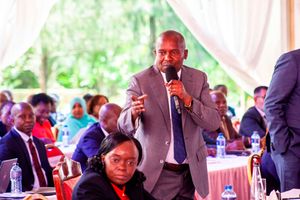Why Kenya must build its own malaria prediction models

A mosquito testing centre. As Kenya strives to become "malaria-free," great strides have been made in data collection—over 90 per cent of health facilities now provide timely malaria reports.
What you need to know:
- About 70 per cent of Kenyans remain at risk, and the transmission risk varies across the country, from a 19 per cent prevalence in lake-endemic regions to less than one percent in low-risk areas.
As the world marks World Malaria Day today, we are reminded not only of the progress we have made in combating the disease, but also of the urgent work that remains to be done.
Imagine a Kenya where malaria surges are predicted before they happen. Where interventions are not just widespread but also smart, targeted, and cost-effective. That future is within reach, and it starts with epidemiological modelling – a data-driven approach used to study and predict the transmission and distribution of malaria by using mathematical and statistical models.
Malaria continues to cast a long shadow over Kenya, threatening millions of lives. The 2024 World Malaria Report estimates 3.3 million cases in 2023—a drop from previous years, but still far too many. About 70 per cent of Kenyans remain at risk, and the transmission risk varies across the country, from a 19 per cent prevalence in lake-endemic regions to less than one percent in low-risk areas.
That uneven risk profile, along with recent troubling trends—such as outbreaks in previously low-transmission areas like Turkana County and the detection of the Anopheles stephensi mosquito, an invasive, urban-adapted species—has complicated Kenya’s malaria fight. This malaria transmitting vector is now confirmed in nine African nations, making the situation more complex than ever.
The detection of the Plasmodium vivax parasite in northern Kenya adds another layer of concern about resurgence and complexity in transmission. Clearly, a one-size-fits-all approach won’t work. We need smarter strategies.
During my time as a field epidemiology resident at Kenya's National Malaria Control Program in 2023, I first encountered the idea of “sub-national tailoring for intervention optimisation”- a powerful concept made possible by epidemiological modelling. Simply put, it means using data and simulation to select the right interventions at the right places at the right times.
However, we hit a roadblock: Kenya lacked enough in-country experts to effectively lead the modelling process. The country heavily relied on external consultants. One key challenge with such setups is lack of familiarity with our local health systems and community contexts. The result? Model results that look good on paper but don’t fully reflect the realities of disease dynamics on the ground.
This gap isn’t unique to Kenya. It's a persistent reality across malaria-endemic countries in Africa. Countries struggle with limited local modelling capacity, leaving them dependent on outside help for essential planning. This disconnect often leads to strategies that are misaligned—or challenging to implement.
As Kenya strives to become "malaria-free," great strides have been made in data collection—over 90 per cent of health facilities now provide timely malaria reports. But we haven't unlocked the full potential of that data. That’s where modelling comes in.
Epidemiological modelling can:
• Incorporate seasonal transmission patterns, climate trends, entomological profiles, and varying coverage of interventions in its analysis.
• Allow for “what-if” analyses, simulating different combinations of interventions such as vector control, chemoprevention, case management and vaccination strategies.
• Identify where to prioritise the limited resources for maximum impact.
This capability is crucial for a country where:
• Only 29 per cent of households have adequate insecticide-treated nets.
• Just 22 per cent of pregnant women receive the recommended three doses of malaria prevention drugs.
• Only 36 per cent of children with fever are tested at health facilities.
By identifying and prioritising optimal strategy mixes, modelling could generate evidence that guide malaria cases reduction while saving money by avoiding ineffective strategies. With the right data and expertise, we could even forecast by how much the interventions could reduce the case burden.
To fully harness the power of modelling, Kenya needs local experts who understand both the math and the local health landscape. Here's how we get there:
• Establish specialised modelling training programmes in local universities to develop a skilled workforce.
• Strengthen data systems to support high-quality analytics.
• Create career pathways within the public health system for disease modellers.
• Foster collaboration between modellers, policymakers, and frontline health workers to ensure modelling insights translate into real-world action.
At the Centre for Epidemiological Modelling and Analysis (CEMA), we are working to build this capacity—not just to produce technically sound models, but to ensure they are locally grounded, policy-relevant, and sustainable. What’s more, the benefits extend far beyond malaria. Modelling can also help combat dengue, cholera, and emerging diseases, making Kenya more resilient to future health threats. This is a strategic investment in our national health security.
To make this vision a reality, Kenya must act. We propose:
• The Ministry of Health should budget at least five per cent of its annual budget over the next five years to develop disease modelling programmes and create public sector roles for modellers.
• Universities and research institutes should develop disease modelling focused Master’s and PhD programmes, tailored to Kenya’s needs and aligned with global best practices.
• Funding agencies, both local and international, should prioritise support for research, training, and data infrastructure to build a sustainable modelling ecosystem.
The journey to a malaria-free Kenya depends not only on having the right tools but also on using them wisely. Epidemiological modelling is a strategy that can guide us to smarter, targeted, and cost-effective decisions. As the World Malaria 2024 Report notes, “tailoring interventions to local settings” is essential to elimination.
For Kenya, that tailoring begins with data, local expertise, and mathematical precision. By building our local modelling capacity now, we can reduce dependence on external consultants, strengthen our health system, and, most importantly, bring us closer to a “malaria-free” Kenya once and for all.
Dr Githinji is a Research Fellow for Malaria Interventions Modelling at the Centre for Epidemiological Modelling and Analysis, at the University of Nairobi

